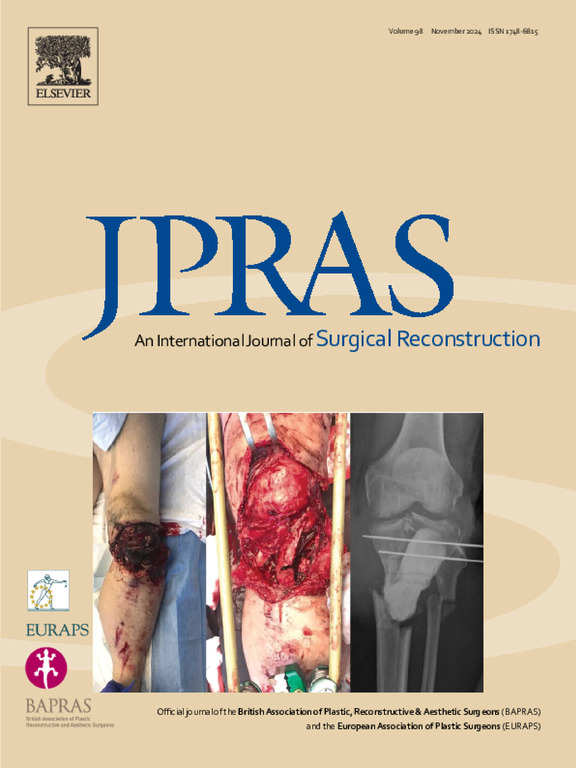Dynamic three-dimensional facial topography in pediatric facial palsy: Understanding asymmetrical facial contours
IF 2
3区 医学
Q2 SURGERY
Journal of Plastic Reconstructive and Aesthetic Surgery
Pub Date : 2024-10-16
DOI:10.1016/j.bjps.2024.10.024
引用次数: 0
Abstract
Background
Objective assessment of facial movements remains pivotal for diagnosis, treatment, and long-term monitoring of patients with facial palsy (FP). This study aims to utilize curvature analysis in pediatric patients with and without FP to define facial contours and to quantify three-dimensional (3D) excursion during smile.
Methods
Pediatric patients with and without FP had 3D motion capture acquired from rest to maximum smile positions. 3D curvature analysis was performed with a custom MATLAB algorithm. A 40-vertex “smile curve” along the nasolabial fold-cheek-orbit contour was extracted from each patient-specific 3D mesh hemiface. This allowed the quantification of excursion and asymmetry for affected vs. unaffected sides in FP patients, and comparison with controls.
Results
Twelve FP (mean 12.5 yr, range 5–18) and 12 control (mean 12.1 yr, range 5–18) patients were analyzed. Differences in facial contour are intensified during animation, especially in the nasolabial fold, cheek, and periorbital regions of interest and the smile curve that links them. Mean excursion differed significantly between the FP and control groups in all regions of interest (p < 0.0001).
Conclusions
Curvature analysis provides insight into the unexplored relationship of the 3D morphological dynamics of the concavity and convexity of the face, to add to the understanding of this complex condition. The magnitude of asymmetry between an FP patient’s affected vs. unaffected smile curve excursion, and comparison to the control group, could allow surgical treatment to be tailored to an individual patient’s dynamic anatomy by identifying and quantifying facial region-specific asymmetry.
小儿面瘫的动态三维面部地形图:了解不对称的面部轮廓。
背景:面部运动的客观评估对于面瘫(FP)患者的诊断、治疗和长期监测至关重要。本研究旨在对患有和未患有面瘫的儿科患者进行曲率分析,以确定面部轮廓并量化微笑时的三维(3D)偏移:方法:对患有和未患有 FP 的儿科患者从静止到最大微笑位置进行三维运动捕捉。采用定制的 MATLAB 算法进行三维曲率分析。从每个患者特定的三维网格半面提取了沿鼻唇沟-颊-眶轮廓的 40 个矢量的 "微笑曲线"。这样就可以量化 FP 患者患侧与非患侧的偏移和不对称情况,并与对照组进行比较:分析了 12 名 FP 患者(平均 12.5 岁,5-18 岁不等)和 12 名对照组患者(平均 12.1 岁,5-18 岁不等)。在动画过程中,面部轮廓的差异会加剧,尤其是在鼻唇沟、脸颊和眶周等相关区域以及连接这些区域的微笑曲线上。FP 组和对照组在所有相关区域的平均偏移量都有显著差异(p 结论:FP 组和对照组在所有相关区域的平均偏移量都有显著差异(p):曲率分析有助于深入了解面部凹凸的三维形态动态关系,从而加深对这一复杂情况的理解。FP 患者受影响与未受影响的微笑曲线偏移之间的不对称程度,以及与对照组的比较,可以通过识别和量化面部特定区域的不对称,使手术治疗符合患者的动态解剖结构。
本文章由计算机程序翻译,如有差异,请以英文原文为准。
求助全文
约1分钟内获得全文
求助全文
来源期刊
CiteScore
3.10
自引率
11.10%
发文量
578
审稿时长
3.5 months
期刊介绍:
JPRAS An International Journal of Surgical Reconstruction is one of the world''s leading international journals, covering all the reconstructive and aesthetic aspects of plastic surgery.
The journal presents the latest surgical procedures with audit and outcome studies of new and established techniques in plastic surgery including: cleft lip and palate and other heads and neck surgery, hand surgery, lower limb trauma, burns, skin cancer, breast surgery and aesthetic surgery.

 求助内容:
求助内容: 应助结果提醒方式:
应助结果提醒方式:


